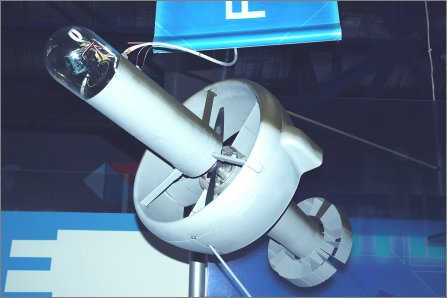Singapore Technologies Aerospace (ST Aero) is continuing work on its developmental MAV-1 low-observable tactical unmanned air vehicle as a focus for a new swarming unmanned air vehicle research programme, but the programme has run into difficulties with the aircraft having flown only once.
|
| A new fantail has been unveiled |
That remotely controlled flight came more than a year later than scheduled. MAV-1 prototypes were unveiled at the 2004 Asian Aerospace show with ST Aero saying at that time that the UAV would fly within months. Dr Tan Jiak Kwang, ST Aero chief engineer and director, advanced systems, describes the single flight as a “hop and pop”, with the aircraft remaining airborne for only a very short period due to airspace restrictions.
Speaking at the conference, Tan said that the air vehicle development effort has been hampered by a lack of aerodynamic data for the batwing configuration as well as difficulties securing flight windows. The Smart Warfighting ARray of configurable Modules (SWARM) project is intended to explore multiple air vehicle operations in a variety of operational roles.
An initial swarm architecture model has been developed and tested using three converted model aircraft equipped with combined satellite and inertial measurement navigation. Initial tests have focused on formation keeping with one aircraft designated as the flight leader and flying under remote control while the other two followed autonomously. Tan says, while the initial studies are at a basic level, “there is still a long way to go”.
The new configuration for ST Aero’s Fantail UAV meanwhile, designated Fantail 5000, supersedes development work on the existing Fantail 3000 variant, but reuses the avionics and flight control actuation systems.
The new version is significantly larger, with an all up length of 1.15m (3.8ft) and a diameter of 0.59m, and carries a larger 3.5hp (2.6kW) two-stroke gasoline engine. Programme officials say the new engine is demonstrating noise reductions of around 10dB compared to the Fantail 3000 configuration. Options for shaping the exhaust are being explored to reduce volume further.
Payload capacity has increased to 0.4kg (0.9lb) with the UAV maximum take-off weight increasing to 5.5kg compared with 2.9kg for the Fantail 3000. Extensive testing of Fantail 3000, including take-off and landings from small boats, revealed the configuration to be “rather limited for operational applications”, says Tan.
Initial flight testing of Fantail 5000 commenced in May 2005 with an incremental approach being taken to expanding the flight envelope to include full transition from vertical to horizontal flight modes by mid 2007. The full system is expected to be production ready by the end of 2007.
Source: Flight International
























